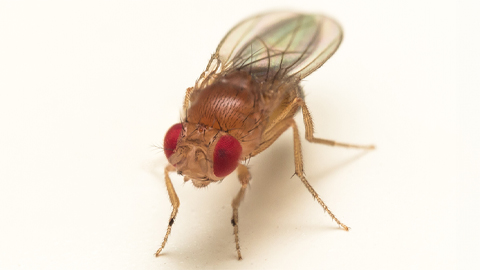Circadian influences on lipid metabolism
Many biological processes are coordinated over time, creating rhythms of biological activity around the 24-hour day. In modern society, humans are often in situations where our behavior or environment – electric lights, food at all hours and shift work, for example – fights the biological circadian clock that coordinates these processes, a conflict that is implicated in a range of health problems from cancer to heart disease.
And it’s not just in humans. A new study by researchers at Julius-Maximilians University in Würzburg, Germany, led by Agnes Fekete and Christian Wegener, provides insights into how the circadian clock and the external environment together regulate lipid metabolism in fruit flies.

The work, recently published in the Journal of Lipid Research, draws on Wegener’s and Fekete’s complementary fields: Wegener studies the circadian clock and Fekete lipid metabolomics. At the intersection were unanswered questions that intrigued them both.
“This combination of expertise that we have makes this special,” Wegener said.
They were curious about lipid levels in hemolymph because this insect blood can serve as a window into metabolism at any given moment. “We were very surprised that there is no publication on the lipid oscillation in the hemolymph,” Wegener said.
They had some doubts that they’d see circadian regulation of lipids this way because so many external influences affect what is in hemolymph at any time.
“When we started this project, we said, ‘Oh of course it won't be rhythmic — we eat. We don't have any regulation from the body — it's all what we eat,’” Fekete said.
They addressed this by feeding the flies a diet lacking lipids; all lipids in the hemolymph had to come from biological processes.
When the flies ate this lipid-free diet, the researchers were amazed to see a clear rhythmicity of lipid transport, with peaks of lipids surrounding the times the lights were turned on in the morning and off at night (an effect that was hidden when the flies ate a lipid-containing diet), indicating underlying circadian control of lipid transport.
They then tracked the effects of activity, feeding, light and a circadian clock mutation. Flies kept in darkness cycled only once per day, while flies with a mutation in the circadian clock didn’t cycle, indicating that the biological circadian clock drives rhythmic lipid transport, while light and dark cycling sets the timing. Activity and feeding behavior didn’t drive the lipid peaks, so the peaks appear to prepare the body for predicted times when it needs to build and restore itself.
Next, Fekete and Wegener want to look into the source of lipids, as well as at other external influences, such as offset light and dark cycles to resemble shift work or a light-polluted environment.
Knowing that organisms regulate lipid transport around the circadian clock has implications for both human biology and the natural world. Flies, like those in the study, and pollinators such as bees also live in our light-polluted world, and we may inadvertently influence their metabolism.
Wegener summed up the relevance of constant clock disruption: “The clock is really good to optimize things but not required. We can live without the clock. However, if you mask the clock for a long time, then you will end up with problems.”
Enjoy reading ASBMB Today?
Become a member to receive the print edition four times a year and the digital edition monthly.
Learn moreGet the latest from ASBMB Today
Enter your email address, and we’ll send you a weekly email with recent articles, interviews and more.
Latest in Science
Science highlights or most popular articles

The science of staying strong
Muscles power every movement, but they also tell the story of aging itself. Scientists are uncovering how strength fades, why some species resist it and what lifestyle and molecular clues could help preserve muscle health for life.

Bacteriophage protein could make queso fresco safer
Researchers characterized the structure and function of PlyP100, a bacteriophage protein that shows promise as a food-safe antimicrobial for preventing Listeria monocytogenes growth in fresh cheeses.

Building the blueprint to block HIV
Wesley Sundquist will present his work on the HIV capsid and revolutionary drug, Lenacapavir, at the ASBMB Annual Meeting, March 7–10, in Maryland.

Gut microbes hijack cancer pathway in high-fat diets
Researchers at the Feinstein Institutes for Medical Research found that a high-fat diet increases ammonia-producing bacteria in the gut microbiome of mice, which in turn disrupts TGF-β signaling and promotes colorectal cancer.

Mapping fentanyl’s cellular footprint
Using a new imaging method, researchers at State University of New York at Buffalo traced fentanyl’s effects inside brain immune cells, revealing how the drug alters lipid droplets, pointing to new paths for addiction diagnostics.

Designing life’s building blocks with AI
Tanja Kortemme, a professor at the University of California, San Francisco, will discuss her research using computational biology to engineer proteins at the 2026 ASBMB Annual Meeting.

